Servicios Personalizados
Revista
Articulo
Indicadores
-
 Citado por SciELO
Citado por SciELO -
 Accesos
Accesos
Links relacionados
-
 Similares en
SciELO
Similares en
SciELO
Compartir
Revista Latinoamericana de Desarrollo Económico
versión impresa ISSN 2074-4706versión On-line ISSN 2309-9038
rlde n.22 La Paz nov. 2014
Social Impacts of Climate Change in Bolivia: A municipal level analysis of the effects of recent climate change on life expectancy, consumption, poverty and inequality
Impactos sociales del cambio climático en Bolivia: un análisis a nivel municipal de los efectos del cambio climático reciente sobre esperanza de vida, consumo, pobreza y desigualdad
Lykke E. Andersen*, Dorte Verner**
Abstract
This paper analyzes the direct evidence of climate change in Bolivia during the last 60 years, and estimates how these changes have affected life expectancy and consumption levels for each of the 311 municipalities in Bolivia. Contrary to the predictions of most General Circulation models, the evidence shows a consistent cooling trend of about 0.2ºC per decade over all highland areas, slight and scattered evidence of warming in the lowlands, and no systematic changes in precipitation. The estimations indicate that the 1ºC cooling experienced in the already cold highlands over the last five decades likely has reduced consumption possibilities by about 2-3% in these areas. Since the much richer population in the lowlands have benefitted slightly from recent climate change, our simulations suggest that recent climate change has contributed to an increase in inequality and poverty in Bolivia. Poor and indigenous peoples in the highlands are among the most severely affected populations.
No statistically significant effect on life expectancy was found.
Keywords: Climate change, social impacts, Bolivia.
Classification JEL: Q51, Q54, O15, O19, O54.
Resumen
Este estudio analiza la evidencia directa del cambio climático en Bolivia durante los últimos 60 años y realiza una estimación de los efectos de estos cambios sobre la esperanza de vida y el nivel de consumo en cada uno de los 311 municipios de Bolivia. En contradicción con la mayoría de los modelos de circulación global, la evidencia directa muestra una tendencia consistente de enfriamiento de aproximadamente 0.2ºC por década en el Altiplano, evidencia esporádica de calentamiento en las tierras bajas, y ninguna tendencia sistemática en las precipitaciones. Las estimaciones indican que el enfriamiento observado de 1ºC en las áreas ya frías del Altiplano durante las últimas cinco décadas probablemente ha reducido el nivel de consumo en 2-3 por ciento en estas áreas. Dado que la población más rica de las tierras bajas se ha beneficiado levemente del cambio climático reciente, nuestras simulaciones sugieren que el cambio climático reciente ha contribuido a un aumento en la pobreza y la desigualdad en Bolivia. Los habitantes pobres e indígenas del Altiplano son los que más han sido afectados. No se ha encontrado un efecto significativo sobre la esperanza de vida.
Palabras clave: Cambio climático, impactos sociales, Bolivia.
Clasificación JEL: Q51, Q54, O15, O19, O54.
1. Introduction1
Although Bolivia is located entirely within the tropics, the large altitude variations within the country imply that it has almost every conceivable type of climate ranging from Andean glaciers, via salt deserts, to steaming rainforest. This variation makes Bolivia ideally suited for an empirical analysis of the social impacts of climate change because the limited variation in the time dimension can be complemented by ample variation in the spatial dimension.
A simple way to gauge how climate affects human development is to compare human development across regions with different climates. This has, for example, been done by Horowitz (2006), which uses a cross-section of 156 countries to estimate the relationship between temperature and income level. The overall relationship found is very strongly negative, with a 2°F increase in global temperatures implying a 13 % drop in income. This is very dramatic, but the relationship is thought to be mostly historical and thus not very relevant for the prediction of the contemporary effects of climate change in the recent past or near future. In order to control for historical factors, the paper includes colonial mortality rates as an explanatory variable, and finds a much more limited, but still highly significant, contemporaneous effect of temperature on incomes. The contemporaneous relationship estimated implies that a 2°F increase in global temperatures would cause approximately a 3.5% drop in World GDP.
In order to further control for historical differences, Horowitz (2006) uses more homogeneous sub-samples, such as one with only OECD countries or only countries from the Former Soviet Union, and the negative relationship still holds. However, as directions for further research, he recommends empirical studies of income and temperature variations within large, heterogeneous countries, which would provide much more thorough control for historical differences. This is exactly what we do in this paper.
Using data from the 311 municipalities in Bolivia, we estimate contemporary relationships between temperature and consumption levels (a proxy for income), as well as between temperature and life expectancy. These relationships are then used to gauge the likely direction and magnitude of effects of climate change in Bolivia.
The rest of the paper is organized as follows. Section 2 describes the data and the sources. Section 3 estimates municipal level econometric models of the relationships between climate variables, life expectancy, and consumption levels. Section 4 analyzes climate change in Bolivia from 1948 to 2008. Section 5 uses the estimated models from Section 3 to simulate the effect of recent climate change (from Section 4) on consumption levels, poverty and inequality.
Finally, Section 6 concludes.
2. The data
The data used for this paper consists of both cross-section and time series data. The municipal level cross-section data base used to estimate the relationships between climate, development and migration in Bolivia is constructed using data from several different sources.
Table 1 lists the variables, their definitions and the sources of the information.
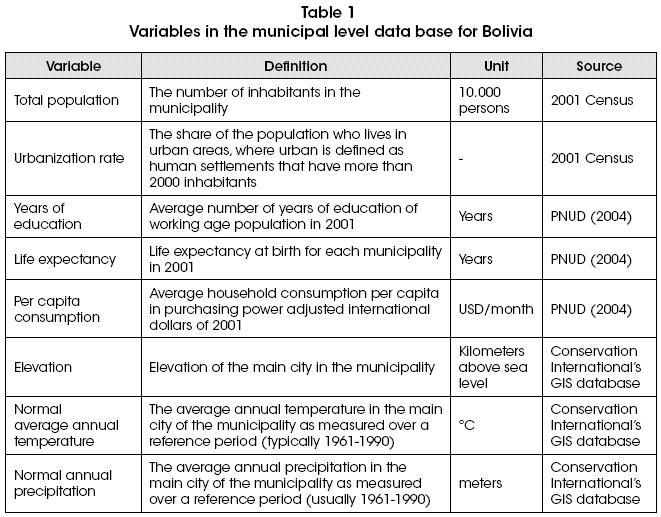
In order to assess the climate change trends in the different parts of Bolivia, we obtained monthly temperature and precipitation data from 1948 to 2008 from the Monthly Climatic Data for the World (MCDW), publication of the US National Climatic Data Center2. The original data is organized in 61 printed volumes with 12 issues in each (one for each month of the year), totaling 721 months. All data has been quality-checked and was published by the NCDC about 3 months after the raw data has been collected. From each of these monthly issues, we extracted average monthly temperature and total monthly for each of 31 Bolivian stations, in order to create time series for each station.
The “normal” temperature for each station-month is calculated as the average temperature observed for the reference period 1960-90. Some stations have so few and scattered observations that it is not feasible to calculate reliable “normal” temperatures, and these stations have therefore been discarded. Only the stations that have at least eight observations for each calendar month during the reference period were included in the analysis in this paper. An additional requirement for inclusion of a data station in the present analysis is that it has at least 300 out of the 721 possible monthly observations. The 18 stations that satisfy both of these requirements are listed in Table 2.
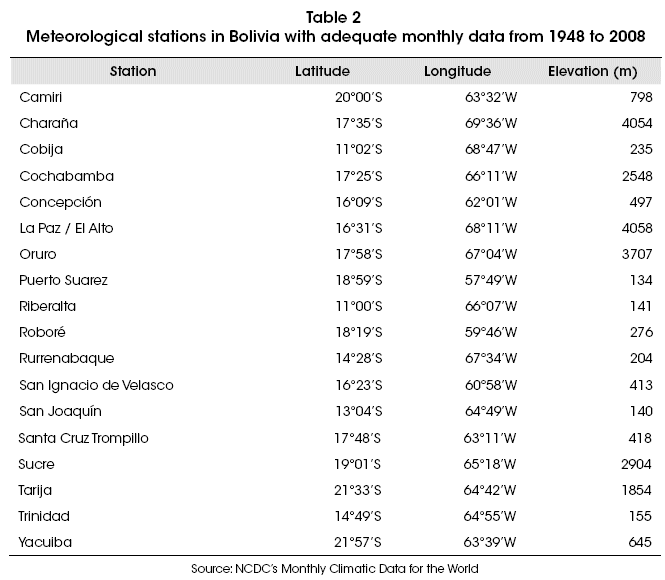
Table 3 shows the average “normal” temperatures for each month for each of these stations.
It is seen that the climate differs dramatically from region to region, with Charaña in the far west being cold throughout the year due to the high elevation, while most low-land regions are hot throughout the year due to the location close to the Equator.
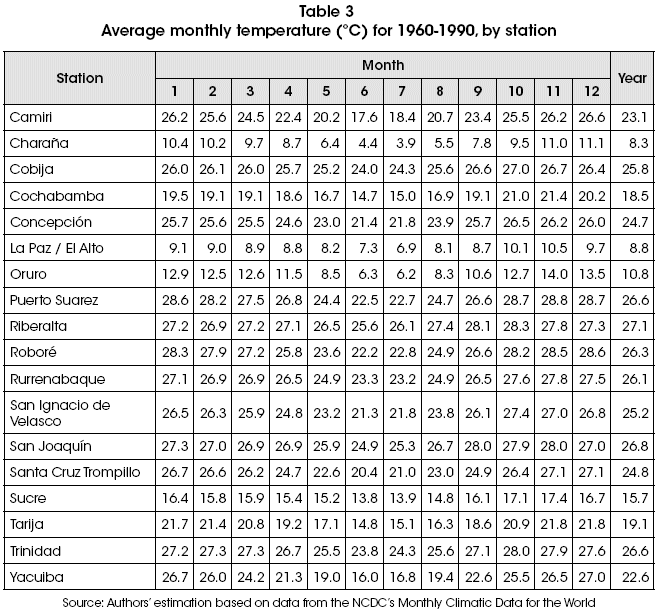
The difference in temperature between the warmest and the coldest month also varies. In Cobija and Riberalta, for example, the difference between the warmest and the coldest month is less than 3ºC. Yacuiba is the southernmost station in Bolivia and therefore the station that shows the most marked temperature variations over the year, but the difference between the warmest and the coldest month is still only 11ºC.
Using the “normal” values for each station and each month, we calculate monthly anomalies for each station for the whole period (actual temperature minus normal temperature for that month). Anomalies are easier to analyze than the raw temperature and precipitation data, since the seasonal variation is eliminated through the subtraction of normal monthly temperatures.
Figure A1 in the Annex plots the temperature anomalies for each station.
The precipitation data applied in the analyses have been subjected to the same procedure, and all precipitation anomalies are plotted in Figure A2 of the Annex.
3. Modeling climate and human development
Bolivia is a very heterogeneous country both with respect to climate and with respect to development. Some regions have extremely harsh climates with sub-zero temperatures most of the year and very little rain. Other regions are hot and constantly humid. Some people live in remote areas without road access in simple one-room dwellings without electricity, piped water, bathroom, or any other basic conveniences. Other people live in mansions with home cinema, swimming pool, fitness room, and servants.
This variation makes Bolivia ideally suited for estimating the impact of climate on development, as the limited variation in time can be complemented by ample variation in space, while still holding the most important confounding variables constant.
As proxies for human development, we will use the following two variables: (i) life expectancy at birth, and (ii) consumption per capita.
Across the 311 municipalities in Bolivia, life expectancy at birth varies between 40 and 70 years, while annual consumption per capita varies between US$ 245 and US$ 2,565 (purchasing power adjusted international dollars of the year 2001).
The variables of principal interest are the climate variables: average temperature and average precipitation. Simple correlations between these and the two human development variables are presented in Table 4. According to these simple correlations, warm and wet is good, while cold and dry is bad for human development.

In order to control for other differences between municipalities, we include the climate variables in a regression framework together with two important control variables: Education levels and urbanization rates, which are both unlikely to be affected by climate changes in the short run, but are clearly related to life expectancy and consumption levels. It is also important to allow for non-linear effects, as both too high and too low temperatures may be unfavorable for human development, just as both too much and too little rain may cause problems (e.g. Mendelsohn, Nordhaus & Shaw, 1994; Quiggin & Horowitz, 1999; Masters & McMillan, 2001; Tol, 2005).
Thus, the regressions in this section will take the following form:
![]()
where ci is a measure of the consumption level in municipality i, tempi and raini are normal average annual temperature and normal accumulated annual precipitation in municipality i, edui is a measure of the education level (average years of schooling of the population aged 15 and older), urbi is the urbanization rate of the municipality, and εi is the error term for municipality i.
The life expectancy regression will take the same form as the consumption regression, except that we will not apply the natural logarithm to the dependent variable. Both regressions are weighted OLS regressions, where the weights consist of the population size in each municipality. The regression results for both consumption and life expectancy are reported in Table 5.

The results at the bottom of the table show that just these four explanatory variables (temperature, precipitation, education and urbanization rates) explain 92% of the variation in consumption levels between the municipalities in Bolivia. This is an extremely good fit, which suggests that we have included the most important explanatory variables, and that including additional variables would make little difference. The same four variables only explain about 74 5% of the variation in life expectancy, which is less impressive, but still very good for a crosssection model.
Education is by far the most important variable, explaining about 88% of the variation in consumption levels and about 54% of the variation in life expectancy. Urbanization rates are also significant in both regressions, in a non-linear manner that suggests that the optimal urbanization rate is around 70% for consumption and about 50% for life expectancy.
The temperature variables are highly significant in explaining consumption, but not life expectancy. Precipitation is not significant in any of the regressions. As it is difficult to assess the non-linear effects of temperature directly by looking at the estimated coefficients, we have plotted the estimated relationship in Figure 1. The axes are scaled to represent the actual range of temperatures and consumption levels in different Bolivian municipalities, so that the magnitude of climate impacts can be seen in the appropriate perspective. A 95% confidence interval on the temperature-consumption relationship is also indicated in the graph.

The estimated relationship indicates that Bolivians do considerably better in hot areas than in cold areas, even when controlling for other factors such as education attainment and urbanization levels. Inhabitants in the hottest regions are able to consume almost twice as much as inhabitants in the coldest regions. The slope is decreasing with temperature, suggesting that already hot areas would benefit only little in terms of consumption from additional increases in temperature, whereas presently cold areas would benefit more.
Having established that temperature has an important effect on consumption possibilities in Bolivia, we will now proceed to test whether there have been any significant changes in temperatures in Bolivia during the last 6 decades.
4. Recent climate change in Bolivia
In this section we will analyze climate data from the 18 meteorological stations of highest quality in Bolivia from May 1948 to May 2008 to test whether there are any significant trends, and whether these trends differ between regions.
The actual measured temperatures are first converted into temperature anomalies, by subtracting the average “normal” temperature for each station-month, as calculated for the reference period 1960-90. All the temperature anomaly series are plotted in Figure A1 in the Annex.
Once we have the series of temperature anomalies, it is straightforward to test whether there is a significant trend. This is done by regressing the anomaly on a trend-variable which has been scaled so that the coefficient can be directly interpreted as temperature change per decade in degrees Celsius. We use a confidence level of 95% to decide whether the trend is statistically significant, which means that the P-value of the trend coefficient should be less than 0.05 for the trend to be significant.
Table 6 shows the estimated trends in temperatures for each of the 18 stations in Bolivia.
Of these, four stations show significant warming since the middle of the previous century and nine show no significant change, and 5 show significant cooling.
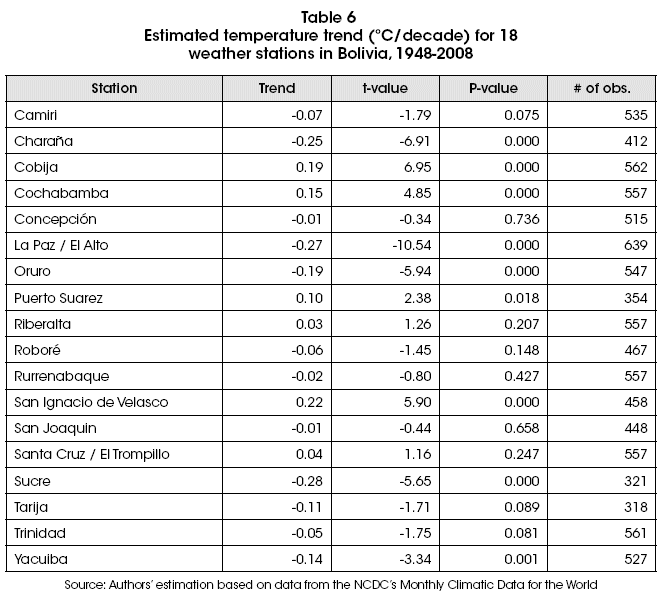
None of the stations in Bolivia get even close to having observations for all the 721 months in the 1948-2008 period, but some stations have reported more consistently than others. If we limit ourselves to the 15 stations that have at least 400 observations, we find that three show significant warming, four show significant cooling, and eight show no significant trend. A similar distribution is found if we limit ourselves to the 11 stations that have at least 500 observations.
The patterns of warming/cooling show a distinct geographical distribution, with the highland stations in the southwestern part of Bolivia showing consistent cooling, and the lowland areas to the north and east showing slight warming (Map 1). This is consistent with NCDC data from neighboring countries, which show cooling in many parts of Peru and Chile but warming in Brazil (Andersen, Suxo & Verner, 2009; Andersen & Verner 2009 and Andersen, Román & Verner, 2009).
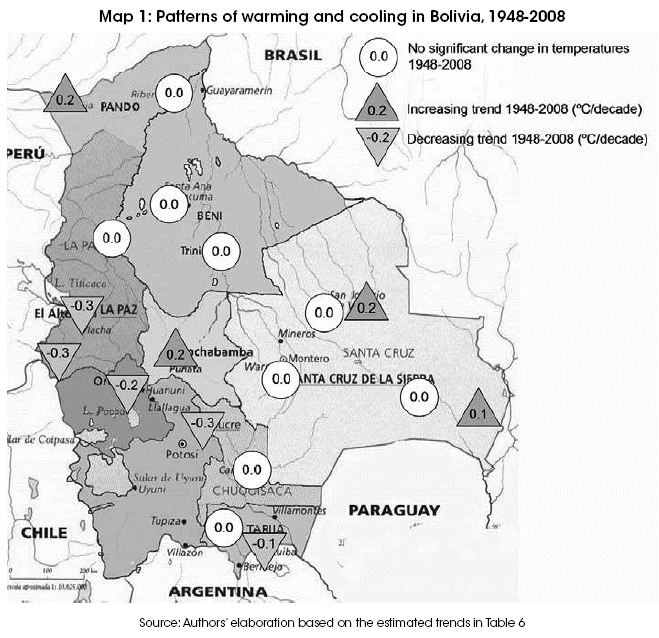
Since the data from any single station is subject to idiosyncratic influences, it is necessary to average over several stations in order to get reliable results. In the case of Bolivia, the data suggests that highland areas in general have experienced cooling over the last 60 years, with an average trend around -0.2ºC/decade. For the purposes of the simulations in the next section, we will therefore assume a uniform cooling trend of 0.2ºC/decade for all municipalities located in the departments of Tarija, Chuquisaca, Potosí, Oruro and the highland areas of La Paz (above 2000 meters above sea level).
For the lowland areas the evidence shows mostly no significant trends, but interspersed with a few positive trends. For the purposes of the simulations in the next section, we will assume a slight warming trend of 0.05ºC/decade in all lowland areas.
The general cooling of the highlands appears to be inconsistent with the rapid melting of several Bolivian glaciers, especially the Chacaltaya and the Zongo glaciers close to El Alto (Francou, Ramirez, Caceres & Mendoza, 2000, and Ramirez, Francou, Ribstein, Descloitres, Guerin, Mendoza, Gallaire, Pouyaud & Jordan, 2001), but it is not. First of all, the glaciers have been melting continuously since the Little Ice Age (about 1550 to 1850), with only a brief slowdown during the relatively cool period of 1950-1980, and it is normal for melting to accelerate towards the end (just like a small ice cube melts faster than a big ice cube).
In addition, glaciers depend on other factors than temperature, notably precipitation, but also cloud cover, relative humidity and the intensity of solar irradiation (Ramirez, 2008). A study of oxygen isotope series generated from ice cores from two Bolivian glaciers suggests that precipitation has decreased steadily since about 1974 (Hoffman, Ramirez, Taupin, Francou, Ribstein, Delmas, Dürr, Gallaire, Simões, Schotterer, Stievenard & Werner, 2003)3.
The reduction in precipitation is likely associated with the general reduction in cloud cover over the tropics since measurements began in the early 1980s4, and less clouds means more intense solar irradiation, which accelerates glacial melt. Decreased cloud cover at this altitude also works to amplify the diurnal temperature range, increasing daytime temperatures (which would cause increased melting), but reducing night-time temperatures even more (because of the missing cloud-blanket), which explains the reduction in average temperatures.
Moreover, upon closer inspection of the temperature data, it becomes clear that temperatures have not fallen equally throughout the year. At the El Alto station, for example, summer temperatures have been increasing and winter temperatures decreasing (Figure 2).
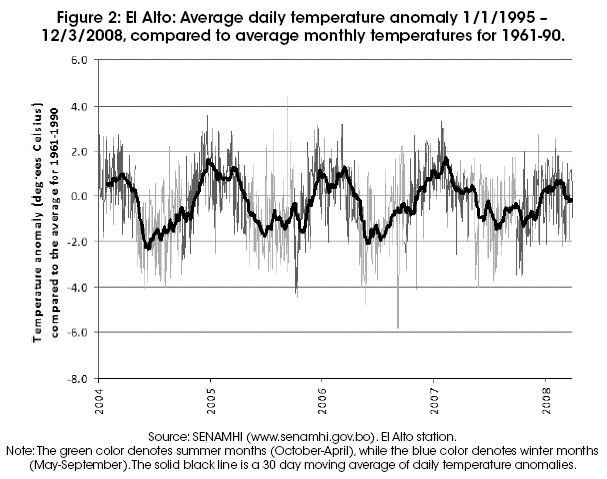
Since winter is the dry season in El Alto, the lower winter temperatures will provide little benefit for the glaciers, which cannot accumulate mass without snowfall. Instead, these glaciers are much more sensitive to changes in summer temperatures and precipitation. This explains why the ENSO (El Niño-Southern Oscillation) has such a strong effect on Bolivian glaciers. During ENSO’s warm and dry phase (El Niño), the mass balances are always negative, implying shrinking glaciers. In the cooler and more humid La Niña phase, the glaciers return to equilibrium and sometimes show a small increase. The increase in the glacier regression rate since the end of the 1970s appears to coincide with the Pacific shift of 1976, the date after which the El Niño event became more frequent and more intense (Ramirez et al., 2001). It was the unusually strong El Niño event of 1997/98, which caused the permanent closing of the World’s highest ski-resort on the Chacaltaya glacier.
The colder winters in the already cold highlands could potentially have an adverse effect on the predominantly poor and indigenous population who inhabit the Bolivian highlands, since one of their main worries and limitations on agricultural productivity is frost (Gonzales Iwanciw, Cusicanqui & Aparicio, n.d.). This is the hypothesis that we will formally test and
quantify in the following section.
We have adequate precipitation data for 19 meteorological stations in Bolivia. The precipitation anomalies for each station have been plotted in Figure A2 in the Annex. Table 7 below shows the results of a simple trend regression for each station.
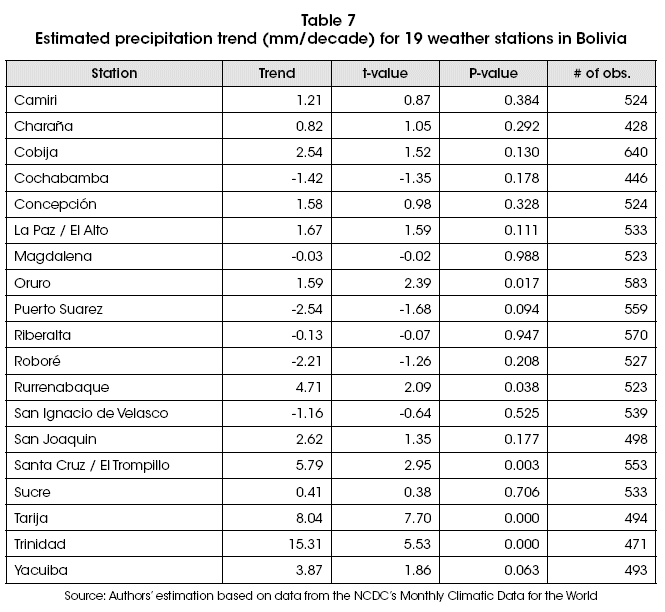
Using a confidence level of 95% we find that only five out of the 19 stations have experienced a significant trend in precipitation over the last six decades, and all of them experienced increases. Oruro in the highlands saw a slight increase of about 1.6 mm/decade, whereas Rurrenabaque, Santa Cruz/El Trompillo, Tarija and Trinidad saw somewhat larger increases.
Since precipitation was not significant in the models of human development estimated in the previous section, it is not very important what we assume about precipitation trends in the simulation exercises in the next section. Only one station in the highlands showed a significant trend, and it was only a very small increase, so it is reasonably to assume that in general there have been no systematic changes in precipitation in the highlands.
Trinidad in the lowlands showed a substantial increasing trend of about 15 mm/decade.
But upon closer inspection of the anomalies (Figure 3) it becomes clear that all of this increase took place before 1978, after which the trend has been negative. Thus, what sometimes appear as a statistically significant trend, is really more of a natural cycle. We will therefore assume no systematic trends in precipitation in the lowlands either.

5. Simulating the impacts of recent climate change
In this section, we will use the consumption model estimated in Section 2 to simulate the impact of the climate change experienced during the last 50 years, as indicated by the analysis in Section 3.
We will compare two scenarios, one with Climate Change, which is the factual scenario, and one with No Climate Change, which is the counterfactual scenario. The temperatures in the Climate Change scenario, ti,CC,, are the actual temperatures, whereas the temperatures in the counterfactual scenario, ti,NCC, are the temperatures that would have been if temperatures had not changed during the last 50 years. That is, for all highland municipalities temperatures are 1ºC higher in the No Climate Change scenario compared to the Climate Change scenario, whereas for all lowland municipalities temperatures are 0.25ºC lower in the No Climate Change scenario.
As there has been no systematic change in precipitation, the precipitation terms cancel out, and the other factors, education and urbanization rates, we will maintain constant, so as
to isolate the climate change effect. Thus the ratio of Climate Change Consumption to No Climate Change Consumption can be written as:

After estimating this ratio for each municipality, it is straightforward to calculate the percentage change in consumption levels that can be attributed to climate change. At the national level, the model estimates that climate change during the last 50 years has caused a reduction in consumption of about 1.3%.
Table 8 shows the results disaggregated at the state level. The most disadvantaged states are the highland states Oruro, Potosí and La Paz, which are estimated to have lost almost 3% of their consumption capacity due to the already cold climates becoming colder. Chuquisaca and Tarija have also lost out according to this simulation, but a bit less, as they were initially warmer, and the slope of the temperature/consumption relationship was thus less steep. All lowland states have gained slightly.
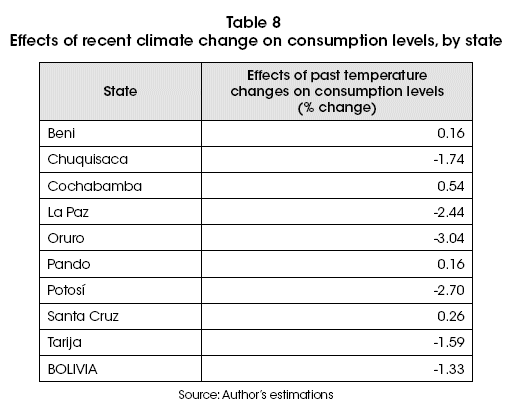
Figure 4 shows the estimated effects of recent climate change on per capita consumption levels in all 311 municipalities. The municipalities are grouped in winners and losers, with no municipality being entirely unaffected. The winners are all lowland municipalities, representing 51% of the population. The losers are all highland municipalities, representing about 49% of the Bolivian population.
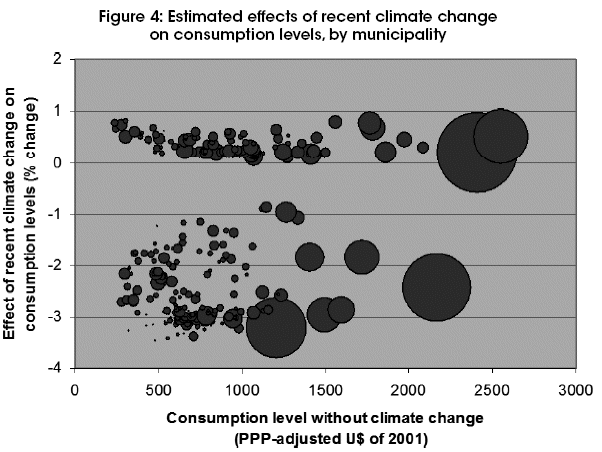
There is a weak but statistically significant positive relationship (ρ = 0.28) between initial level of consumption and the estimated effects of past climate change. This suggests that it is generally the poorest municipalities which have experienced the most negative effects of recent climate change, implying that recent climate change has contributed to an increase in both poverty and inequality.
The poor highland municipalities, which are most adversely affected, also happen to have much larger proportions of indigenous populations than the lowland municipalities which have benefitted from recent climate change. This implies that the indigenous people of Bolivia are on average more adversely affected from recent climate change than the non-indigenous population, simply because they happen to live in areas where the climate has turned less beneficial for human development (colder).
6. Conclusions
This paper has analyzed the direct evidence of climate change in Bolivia over the last 60 years. Contrary to expectations, and contrary to the predictions of most General Circulation models, this evidence shows a consistent cooling trend of about 0.2ºC per decade over all highland areas, and only slight, scattered evidence of warming in the lowland areas. No systematic trends in precipitation were detected, only decade-long cycles. There are indications that the decrease in average temperatures in the highlands is hiding an increase in daytime and summer temperatures but a decrease in nighttime and winter temperatures, although much more detailed daily temperature records would be needed to confirm this.
Using municipality level data, models of the relationships between climate, life expectancy and consumption levels were estimated (controlling for other factors that might affect life expectancy and consumption levels). The results suggest that consumption possibilities in Bolivia increase with temperature, but at a decreasing rate. Consumption levels are almost twice as large in the warmest parts of Bolivia compared to the coldest parts (when controlling for differences in education levels, urbanization rates, and precipitation). Precipitation, however, was not found to have any systematic effect on consumption levels. Neither temperature nor precipitation was found to have any systematic effects on life expectancy.
When simulating the impact of recent climate change in Bolivia (1ºC reduction in temperatures in the already cold highlands, and a 0.25ºC increase in temperatures in the already hot lowlands over the last 50 years), we found an adverse impact on national consumption levels of 1.3%. Since the predominantly poor and indigenous population in the highlands experienced a negative effect due to recent cooling and the much richer population in the lowlands experienced slightly positive effects of modest warming, the overall effect of recent climate change would be an increase in inequality between Bolivian municipalities and an increase in poverty.
Notice that this is due to the direction of recent climate changes in Bolivia, and not due to any inherent characteristics of the poor which might make them more vulnerable to climate change. If recent climate change had showed warming across the country (as climate models typically suggest), then the poor in the highlands would have benefited much more than the rich in the lowlands, thus reducing poverty and inequality.
The magnitudes of the estimated impacts are not large, however. A reduction in consumption levels of 3-4% (the most adverse effects encountered) over a 50 year period corresponds to just one year of low growth.
It is important to keep in mind that the approach of this paper is designed to capture the long term effects of climate change, after people have adjusted to the changed climate. The paper does not address transition costs and costs of normal climate variability. This is a reasonable approach if climate change takes place slowly and predictably, so that people can gradually adjust their behaviors (for example, by sowing a different crop than their parents used to). It is assumed that people base their economic decisions on what their current climate is like, rather than on what the climate was like a generation ago, just as they should base their economic decisions on current market conditions rather than on market conditions 30 years earlier.
It is also assumed that for any given temperature-precipitation combination, climate has not become more unpredictable. At the aggregate level, however, predictability may have changed, since there are now more municipalities with lower temperatures. Places where temperatures oscillate close to the freezing point inherently have more unpredictable weather than places which are consistently hot and humid, and temperature variations close to zero have more severe consequences. Indeed, we find that the two highland stations, Oruro and Charaña, have experienced increased variability in temperatures. But the rest of the stations have experienced no significant changes in variability or even reduced variability. With respect to precipitation, we found three stations (Cobija, Yacuiba and San Javier) that had higher precipitation variability since 1991 compared to the reference period 1960-90. The rest had either lower or unchanged variability.
The modest impacts of climate change (the slow, systematic changes in average temperature and precipitation) do not preclude large impacts from climate variability. Indeed many studies have evaluated the costs of El Niño and La Niña events in Bolivia (causing extreme droughts and flooding) finding costs of up to 18% of annual GDP for the 1982-83 El Niño event; 7% for the 1997-98 El Niño; 4.2% from the 2006-2007 El Niño; and 3.4% from the 2007-2008 La Niña event (Bolivia 2004; CAF 2000; CEPAL 2007 and 2008).
Predicting the effects of future climate change
While recent climate change can be analyzed and documented using temperature and precipitation records from weather stations spread across the national territory, it is much more difficult to assess the impacts of future climate change, because there is very little scientific consensus about how the local climates in Bolivia are going to change in the future.
The Intergovernmental Panel on Climate Change uses a combination of different General Circulation Models to predict future climates. For some regions these models do a reasonably good job at replicating past climate change and current climatic conditions, and there is a high level of agreement between the many different models. This is not the case for South America in general, and even less the case for Bolivia. Not a single model has replicated the recent temperature reductions observed across most of Bolivia. According to the IPCC4, Working Group I chapter on Regional Climate Projections for Latin America:
The systematic errors in simulating current mean tropical climate and its variability and the large inter-model differences in future changes in El Niño amplitude preclude a conclusive assessment of the regional changes over large areas of Central and South America. (…)
The high and sharp Andes Mountains are unresolved in low resolution models, affecting the assessment over much of the continent (Christensen et al., 2007).
Despite this uncertainty, the IPCC report finds it very likely that temperatures will increase over all areas of South America over the rest of this century. If this turns out to be true, the recent cooling trend would be reverted, and the climate in Bolivia might return to “normal” (the 1961-90 average) within the next 2-3 decades.
However, “normal” climate in Bolivia includes tremendous climate variability with either El Niño or La Niña conditions almost every year. If each of these events causes losses of 3-4%
of GDP, they make all the difference between a country growing steadily towards prosperity and a country permanently stuck in poverty. Vulnerability has clearly been reduced since
the devastating El Niño episode of 1982-83, but further steps to reduce vulnerability are still necessary.
Artículo recibido en: 20 de junio de 2009
Manejado por: ABCE
Aceptado en: 18 de septiembre de 2014
References
1. Andersen, L. E. & D. Verner (2009). “Social Impacts of Climate Change in Chile: A municipal level analysis of the effects of recent and future climate change on human development and inequality, Draft, February.
2. Andersen, L. E., A. Suxo & D. Verner (2009). “Social Impacts of Climate Change in Peru: A district level analysis of the effects of recent and future climate change on human development and inequality, Draft, February.
3. Andersen, L. E., S. Román & D. Verner (2009). “Social Impacts of Climate Change in Brazil: A municipal level analysis of the effects of recent and future climate change on human development and inequality, Draft, February.
4. Bolivia (2004) “La gestión del riesgo en Bolivia.” Ministerio de Defensa Nacional de Bolivia.
5. Brown, Lawrence A. & John Paul Jones III (1985). “Spatial Variation in Migration Processes and Development: A Costa Rican Example of Conventional Modeling Augmented by the Expansion Method.” Demography, 22(3), 327-352.
6. CAF (2000) “Las lecciones de El Niño – Bolivia.” Corporación Andina de Fomento, Caracas, Venezuela
7. CEPAL (2007). “Informe sobre el impacto del fenómeno de El Niño en Bolivia.” Comisión Económica para América Latina y El Caribe, April.
8. CEPAL (2008). “Informe sobre el impacto del fenómeno de La Niña en Bolivia.” Comisión Económica para América Latina y El Caribe, April.
9. Christensen, J.H., B. Hewitson, A. Busuioc, A. Chen, X. Gao, I. Held, R. Jones, R.K. Kolli, W.-T. Kwon, R. Laprise, V. Magaña Rueda, L. Mearns, C.G. Menéndez, J. Räisänen, A. Rinke, A. Sarr and P. Whetton (2007). “Regional Climate Projections.” In: S. Solomon, D. Qin, M. Manning, Z. Chen, M. Marquis, K.B. Averyt, M. Tignor and H.L. Miller (eds.), Climate Change 2007: The Physical Science Basis. Contribution of Working Group I to the Fourth Assessment Report of the Intergovernmental Panel on Climate Change. Cambridge University Press, Cambridge, United Kingdom and New York, NY, USA.
10. Francou, B., E. Ramirez, B. Caceres & J. Mendoza (2000). “Glacier evolution in the Tropical Andes during the last decades of the 20th Century: Chacaltaya, Bolivia, and Antizana, Ecuador.” Ambio, 29(7): 416 -422.
11. Gonzales Iwanciw, J., J. Cusicanqui Giles & M. Aparicio Effen (n.d.). “Vulnerabilidad y adaptación al cambio Climático en las regiones del Lago Titicaca y los valles cruceños de Bolivia: sistematización de los resultados de la investigación participativa, consultas y estudios de caso.” Ministerio de Planificación del Desarrollo, Programa Nacional de Cambios Climáticos, Bolivia.
12. Hoffmann, G., E. Ramirez, J. D. Taupin, B. Francou, P. Ribstein, R. Delmas, H. Dürr, R. Gallaire, J. Simões, U. Schotterer, M. Stievenard & M. Werner (2003). “Coherent isotope history of Andean ice cores over the last century.” Geophysical Research Letters, 30(4): 1179-1182.
13. Horowitz, J. K. (2006). “The Income-Temperature Relationship in a Cross-Section of Countries and its Implications for Global Warming.” Department of Agricultural and Resource Economics, University of Maryland, Submitted manuscript, July. Available in: http://faculty.arec.umd.edu/jhorowitz/Income-Temp-i.pdf
14. Masters, W. A. & M. S. McMillan (2001). “Climate and Scale in Economic Growth,” Journal of Economic Growth, 6(3): 167-186.
15. Mendelsohn, R., W. Nordhaus & D. Shaw (1994). “The Impact of Global Warming on Agriculture: A Ricardian Analysis,” American Economic Review, 84(4): 753-71.
16. PNUD (2004). Índice de Desarrollo Humano en los municipios de Bolivia. Informe Nacional de Desarrollo Humano 2004, La Paz, Bolivia. [ Links ]
17. Quiggin, J. & J. K. Horowitz (1999). “The Impact of Global Warming on Agriculture: A Ricardian Analysis: Comment,” American Economic Review, 89(4): 1044-45.
18. Ramírez, E. (2008). “Impactos del cambio climático y gestión del agua sobre la disponibilidad de recursos hídricos para las ciudades de La Paz y El Alto.” Revista Virtual REDESMA, 2(3): 49-61.
19. Ramírez, E., B. Francou, P. Ribstein, M. Descloitres, R. Guerin, J. Mendoza, R. Gallaire, B. Pouyaud, & E. Jordan (2001). “Small glaciers disappearing in the tropical Andes. A case study in Bolivia: Glaciar Chacaltaya (16°S).” Journal of Glaciology, 47(157): 187-194.
20. Tol, R. S. J. (2005) “Emission abatement versus development as strategies to reduce vulnerability to climate change: an application of FUND.” Environment and Development Economics, 10: 615-629.
21. Trenberth, K.E., P.D. Jones, P. Ambenje, R. Bojariu, D. Easterling, A. Klein Tank, D. Parker, F. Rahimzadeh, J.A. Renwick, M. Rusticucci, B. Soden and P. Zhai (2007). “Observations: Surface and Atmospheric Climate Change.” In: S. Solomon, D. Qin, M. Manning, Z. Chen, M. Marquis, K.B. Averyt, M. Tignor and H.L. Miller (eds.) Climate Change 2007: The Physical Science Basis. Contribution of Working Group I to the Fourth assessment Report of the Intergovernmental Panel on Climate Change. Cambridge University Press, Cambridge, United Kingdom and New York, NY, USA.
Annex:
Monthly temperature and precipitation anomalies
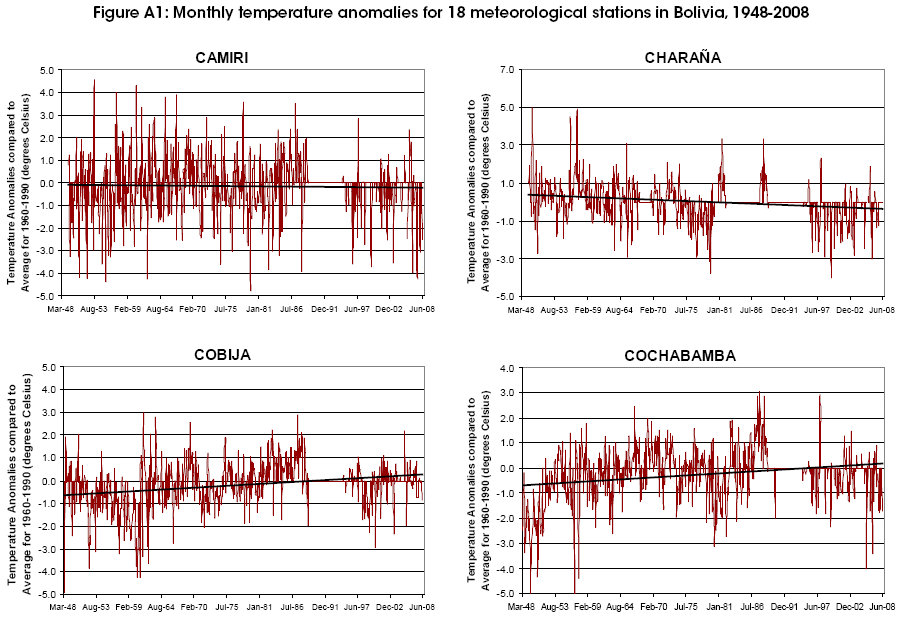
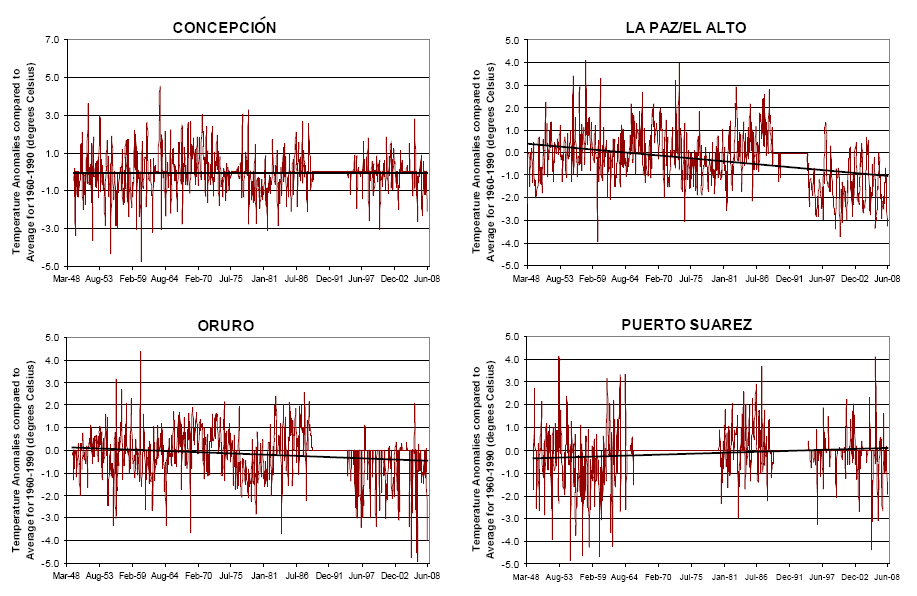
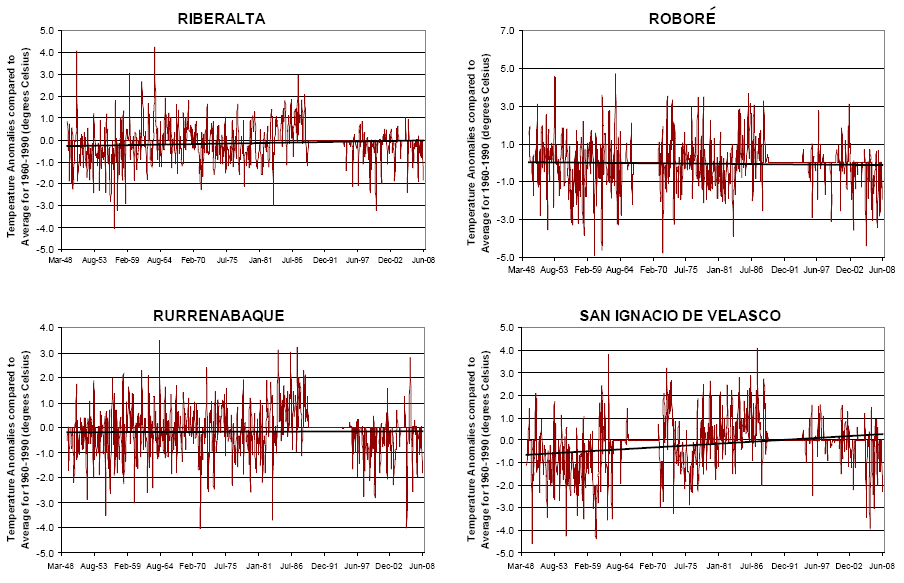
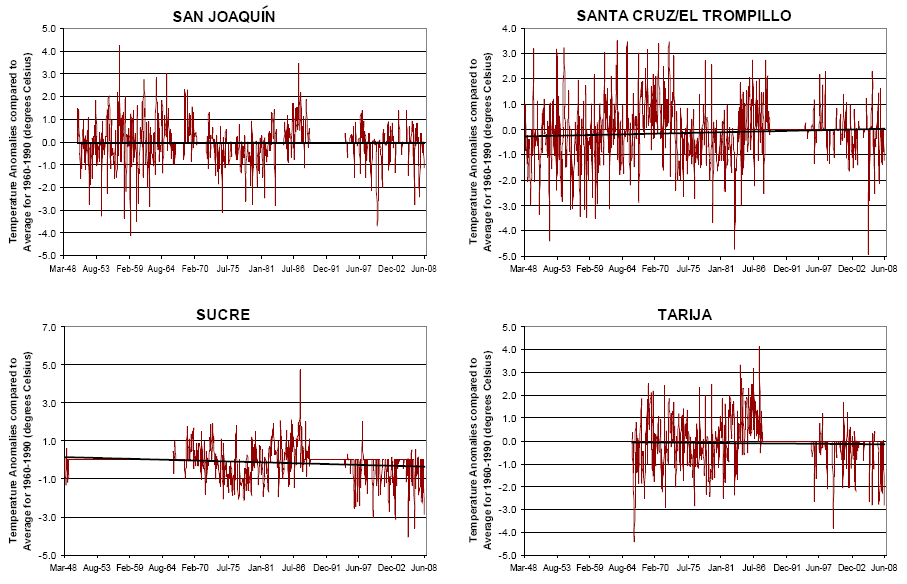
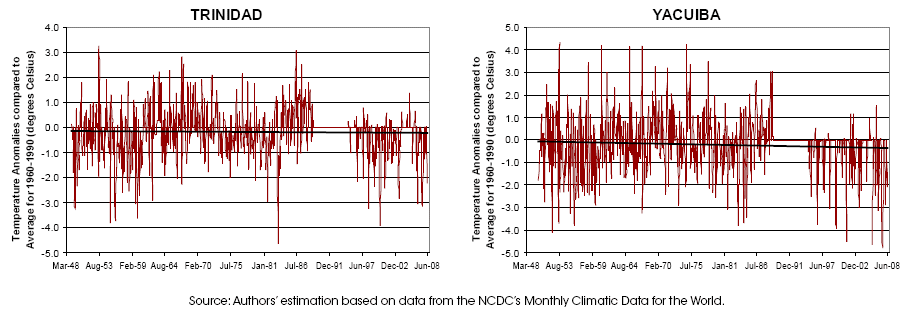
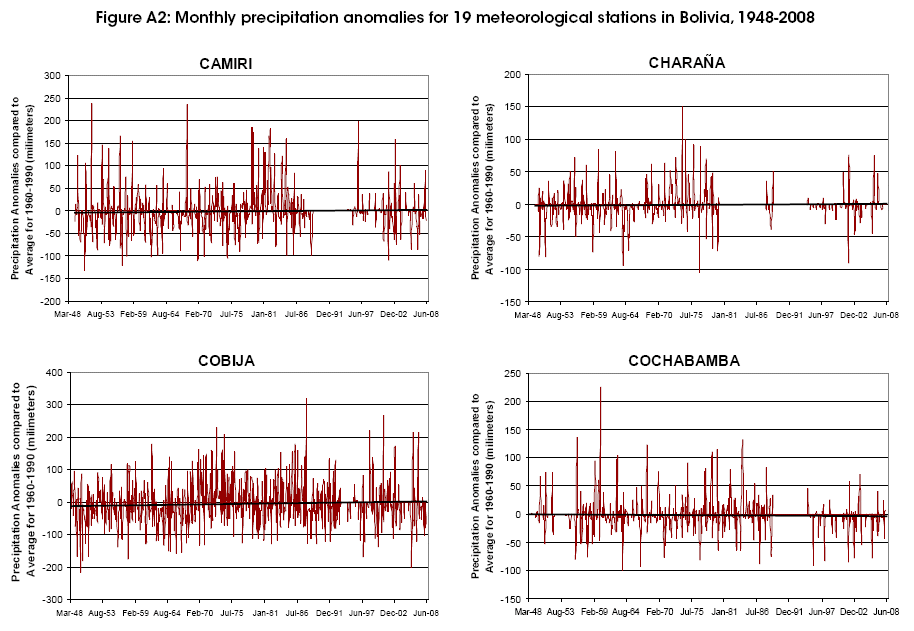
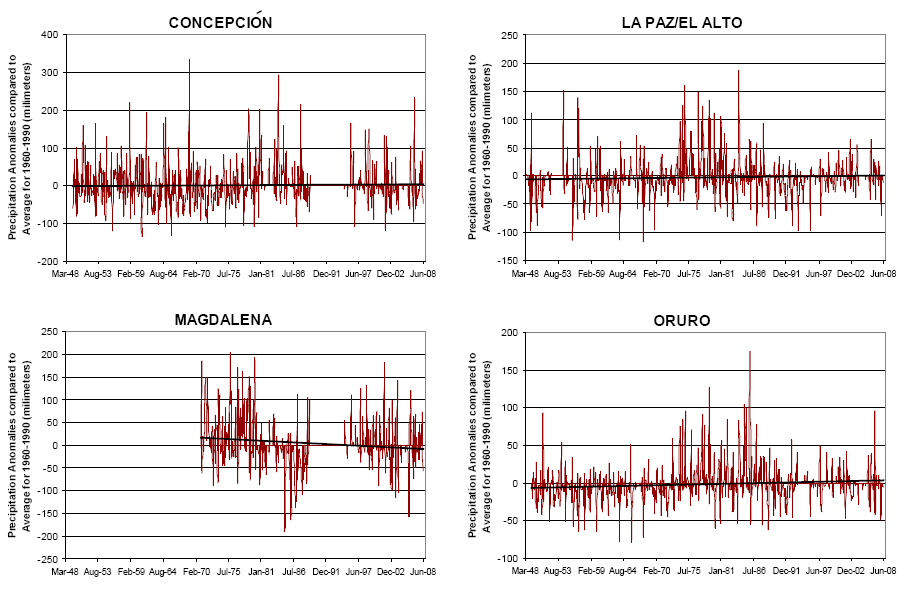
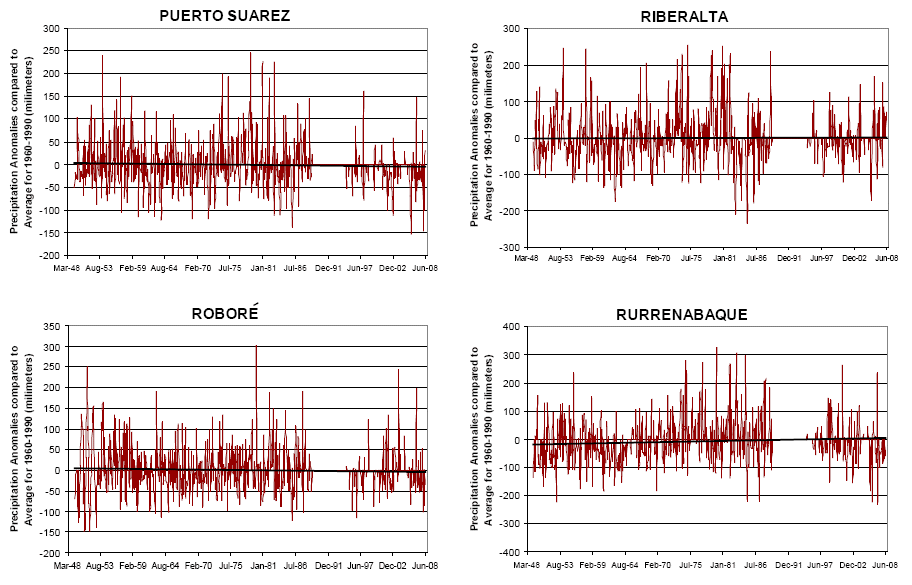
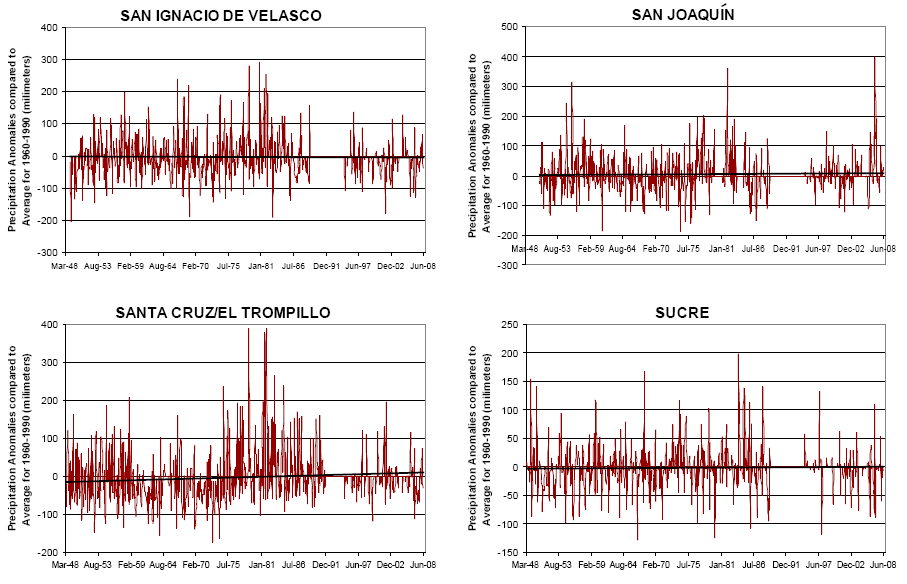
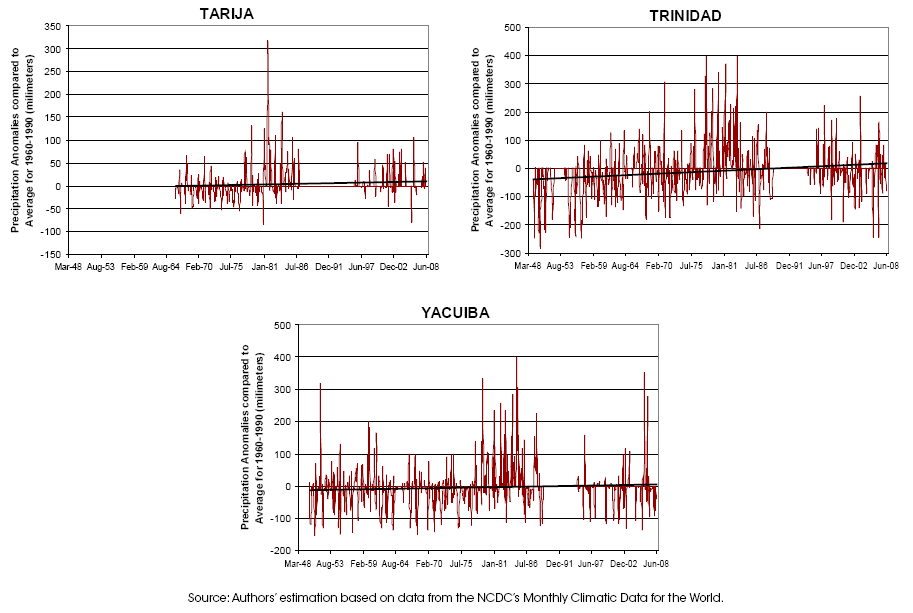
Notas
* Institute for Advanced Development Studies (INESAD) and Universidad Privada Boliviana (UPB), La Paz, Bolivia.
Contact: landersen@inesad.edu.bo
** Office of Evaluation and Oversight, Inter-American Development Bank, Washington D.C.
Contact: DORTEV@iadb.org.
1 This paper forms part of the World Bank research project “Social Impacts of Climate Change and Environmental Degradation in the LAC Region.” The authors greatly appreciate the comments, uggestions and inputs received from Pablo Fajnzylber, Kirk Hamilton, Jacoby Hanan, Jens Hesselbjerg Christensen, Jakob Kronik, Andrea Liverani, Joergen Eivind Olesen, Claus Pörtner, Tine Rossing, Olivier Rubin, Emmanuel Skoufias, Fabián Soria and Addy Suxo. The findings, interpretations and conclusions expressed in this paper are those of the authors and do not necessarily reflect the views of the Executive Directors of The World Bank or the governments they represent.
2 This data is available for free at http://www7.ncdc.noaa.gov/IPS/mcdw/mcdw.html.
3 However, this decrease is not considered unusual in a historical context and over the whole 20th century the isotope index is stable
4 According to NASA’s International Satellite Cloud Climatology Project – ISCCP (http://isccp.giss.nasa.gov/index.html), average tropical cloud cover has decreased from about 66% in the 1980s to about 61% in the first 8 years of this century.














